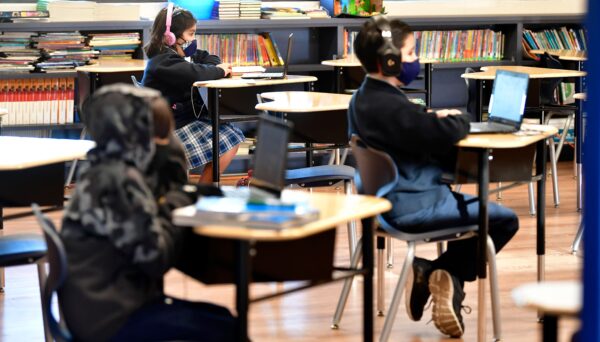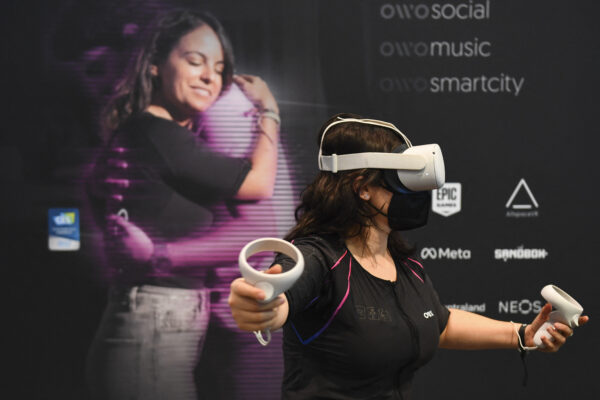Educators Say Artificial Intelligence, Virtual Reality Use in Classrooms Needs Limits
Technology in U.S. classrooms is about to jump a level this year with research showing virtual reality, artificial intelligence, and gamification are set to be among the top education trends in 2023.
High-tech and game-related components are quickly becoming a new reality in classrooms, and some teachers are concerned.
Part of that is because it’s happening amid the backdrop of increased anxiety and depression in students.
There has also been a surge in problematic behavior since the return to in-person classes in 2021.

Then there are plummeting grades to address. Test scores in multiple subjects and age groups in the United States reached historic lows in 2022.
As a result, many U.S. educators suggest that leaning too hard on cutting-edge tech could hinder students without proper guidelines.
Others say creating less face time in the classroom would be ignoring important lessons learned during the COVID-19 pandemic.
“If we learned anything from the shutdown in the world and in the education system during the height of COVID, it was that students missed out greatly during their time online,” Pamela Morris told The Epoch Times.
Morris is an early childhood education director in Chandler, Arizona. She noted that a lot of vital learning takes place through face-to-face interactions. This is especially true for younger children.
In her estimation, reducing in-person learning could have negative consequences.

Increased screen time has already been linked to behavioral problems in students, including poor focus, depression, and anxiety. Morris suggests bringing more tech into classrooms could make things even worse.
“All an educator needs to do is see what their students look like when they are texting their friends,” Morris said.
‘They zone out, lose focus, and often are irritable when the device has to be put away. I think it would be irresponsible to make this type of learning a large part of the day.”
During the pandemic, student social skills were heavily impacted by the lack of physical interactions with peers. In turn, it created a surge in depression and anxiety for children of all ages.
“I go back to COVID and the amount of socialization that was lost,” she said, adding, “This negatively affected students to the point some chose to wear a mask just so they could hide.”
However, as the old saying goes: You can’t stop progress.
One report projects the growth of augmented and virtual reality (VR) in education to grow by more than 18 percent by 2027. The market for artificial intelligence (AI) use in education represented a $3.7 billion industry in 2022 and is forecasted to grow to more than $20 billion within the next four years.
Gamification already has its foot inside the door with today’s youth. As of 2019, 73 percent of American kids 2 years or older play video games every day.
Predetermined Outcomes
Other educators say there’s an elephant in the room to address amid the rush to mainstream tools like AI, VR, and gamification. Where do we go from here, and to what end will this technology be used?
Former superintendent, teacher, and student counselor Gary Marks says guidelines are needed before increasing technology in classrooms.
“I personally believe that all innovative methods of instruction should be advanced but with specific goals developed before implementing new ideas and predetermined outcomes,” Marks told The Epoch Times.
He says time management is important and believes tools like AI and VR need to be strictly supplemental in education.
“If the school administration deems that technology will be more than supplemental, I fear this is a George Orwell 1984 scenario,” he said.
“If AI, VR, and video games become the mainstream method of instruction, the world is at risk of a major meltdown. Students will not be making decisions based on normal human behaviors, but on some robot or game that’s not reality.”
Many tech advocates say things like AI and VR won’t replace teachers in the classroom. Though the executive director of STEM4Real, Dr. Leena Bakshi McLean, said some educators are already moving in that direction.
“I recently saw an ed-tech company advertise that their teaching is done through technology and not teachers,” McLean told The Epoch Times.
She cautions administrators and leaders from using tech to replace teachers but adds that tools like AI and VR could be great supplements.
“The authentic relationships, mentoring, and guidance from teachers cannot be replaced by any of these trends,” she said.
Modified Behavior
Advanced technology does come with some benefits. Things like better hand-eye coordination and new opportunities for creativity are among the perks.
On the other side of the coin, it fuels behavior challenges like increased aggression, underdeveloped social skills, and an inability to focus.
“The increased use of AI, VR, and game-based technology will absolutely contribute to the difficulty of focusing and behavioral challenges,
especially if these tools are being used to replace teachers,” McLean said, adding, “This can potentially and completely dehumanize education.”
She says there’s potential in using cutting-edge tech in the classroom, but—like Marks—McLean also believes it needs to be limited.
During a 2022 National Center for Education Statistics survey, 56 percent of U.S. schools reported higher incidents of classroom disruption and misconduct.
Forty-nine percent recorded rowdiness outside class, and 48 percent noted acts of disrespect towards teachers and staff.
“As with most things in our society, balance is required. For young developing minds, this skill has to be taught and reinforced continually,” Marks added.
He noted that although tools like AI and VR will modify human behaviors, interactions among people will always be necessary for developing vital problem-solving skills and coping mechanisms.
McLean agrees with this sentiment and says it’s about balance.
“As a parent myself, I strive to ensure that we limit screen time as much as possible for the development of my child. However, I also want to be mindful of the growing technologies that I want my child to learn.”





